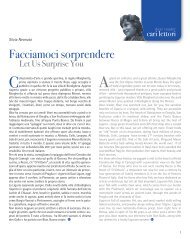BLUE NEW 31_215x270 - Blue Liguria - Sagep
BLUE NEW 31_215x270 - Blue Liguria - Sagep
BLUE NEW 31_215x270 - Blue Liguria - Sagep
Create successful ePaper yourself
Turn your PDF publications into a flip-book with our unique Google optimized e-Paper software.
lue<br />
book<br />
Il romanzo (vero) dei Templari<br />
A (True) Story of the Templars Alberto Leiss<br />
autore della orribile strage<br />
L’ sull’isola di Utoya, Anders<br />
Behring Brevik, ha scritto un libro<br />
di 1.500 pagine autodefinendosi il<br />
capo dei “nuovi cavalieri templari”,<br />
la cui “missione” sarebbe quella di<br />
eliminare il nemico assoluto<br />
rappresentato dall’Islam e da tutti<br />
gli immigrati che insidiano<br />
l’Europa. E’ un indizio estremo della<br />
suggestione che ancora esercita la<br />
storia e la leggenda dei Templari<br />
(ingredienti anche di tanta<br />
fortunata fiction contemporanea).<br />
L’ordine dei frati-cavalieri cristiani<br />
ebbe un ruolo molto importante al<br />
tempo delle prime crociate (la<br />
prima avvenne tra il 1096 e il 1099)<br />
e prosperò fino al 1<strong>31</strong>2, quando -<br />
divenuto anche una potenza<br />
immobiliare e finanziaria “globale”<br />
per l’epoca, contro la quale si era<br />
scagliato il sovrano francese Filippo<br />
il Bello – fu soppresso, ma non<br />
condannato, da papa Clemente V.<br />
Chi volesse saperne di più, evitando<br />
le tante distorsioni fantasiose che<br />
circondano la vicenda,<br />
può leggere il libro<br />
appena uscito di<br />
Simonetta<br />
Cerrini,<br />
L’apocalisse<br />
dei Templari,<br />
edito da<br />
The instigator of the horrible<br />
recent massacre on the<br />
Norwegian Island of Utoya,<br />
Anders Behring Brevik, has<br />
written a 1,500 page book after<br />
having crowned himself the head<br />
of “the New Knights Templar”,<br />
whose “mission” is to eliminate<br />
the final enemy, Islam, and all the<br />
immigrants who are invading<br />
Europe. This is an extreme<br />
indication of the power that the<br />
history and the legend of the<br />
Templar Knights (a vital<br />
ingredient in the fortune of so<br />
much contemporary fiction)<br />
holds. The order of the Christian<br />
monk-knights had an important<br />
role at the time of the first<br />
crusades (the very first took place<br />
between 1096 and 1099) and<br />
prospered until 1<strong>31</strong>2, when –<br />
having become a financial and<br />
property-holding “global” power<br />
of the times – the King of France,<br />
Philip the Beautiful attacked the<br />
order. It was henceforth<br />
suppressed, but not condemned,<br />
by Pope Clement V.<br />
For those who want to know<br />
more, while avoiding the many<br />
imaginative distortions that have<br />
inserted themselves between the<br />
facts, it is worth reading the<br />
compelling novel, just out, by<br />
Simonetta Cerrini, L’apocalisse<br />
dei Templari, (The Apocalypse of<br />
the Templars)<br />
published by<br />
Mondadori. L’autrice, ligure, studia<br />
da vent’anni la storia dei Cavalieri<br />
del Tempio – ha già pubblicato nel<br />
2008 un altro libro: La rivoluzione<br />
dei Templari – e ne scrive unendo<br />
alla grande competenza scientifica<br />
una passione e un gusto del<br />
racconto che fanno di questo testo<br />
anche un avvincente romanzo.<br />
La traccia narrativa è costituita<br />
dalle immagini di un affresco che si<br />
trova nella basilica “templare” di<br />
San Bevignate, a Perugia. Sono<br />
quattro quadri: il primo,<br />
fondamentale, ricostruisce gli<br />
schieramenti di una battaglia, dove<br />
si riconoscono i Templari. Gli altri<br />
tre sintetizzano allegoricamente la<br />
vita, la cultura e la vocazione<br />
dell’ordine e insieme costituiscono i<br />
capitoli del libro.<br />
La tesi fondamentale dell’autrice<br />
Simonetta Cerrini,<br />
autrice de L'apocalisse<br />
dei Templari<br />
Simonetta Cerrini, author<br />
of the book, Apocalpsye<br />
of the Templars,<br />
L'apocalisse dei Templari<br />
Mondadori. The <strong>Liguria</strong>n author<br />
has been studying the history<br />
of the Knights Templar for<br />
twenty years now. Her first<br />
book on the subject was<br />
published in 2008, La<br />
rivoluzione dei Templari (The<br />
Revolution of the Templars),<br />
and the tale she is now offering<br />
unites her scientific<br />
competence with her storytelling<br />
abilities.<br />
The plot comes from the images<br />
of a fresco which is found in<br />
the “Templar Basilica” of San<br />
Bevignate, in Perugia. There are<br />
four panels: the first, and<br />
fundamental, shows scenes<br />
from a battle where the<br />
Templars are clearly seen. The<br />
other three are allegories to<br />
life, culture, and the vocation<br />
of the order. Together they<br />
form the chapters of the book.<br />
The author wishes to bring to<br />
life the choices and the drama<br />
of the Templars. The group of<br />
nobles embraced “poverty” to<br />
place themselves and their arms<br />
at the service of the Church.<br />
They wanted to react to the<br />
“sense of failure which<br />
followed upon the bloody<br />
conquest of Jerusalem in 1099.<br />
From this existentialist defeat<br />
the Knights Templar would<br />
manage to bring a ‘new world<br />
to life.’”<br />
The fundamental tension in the<br />
Templar experience for<br />
Simonetta Cerrini lies in the<br />
contradiction between the<br />
religious vocation and the<br />
military role. This even<br />
embarrassed the Church. It had<br />
98









